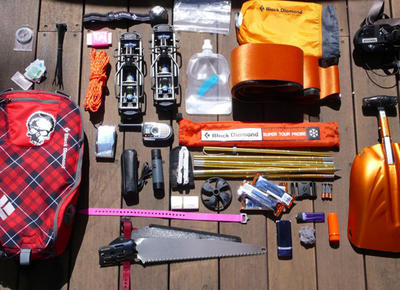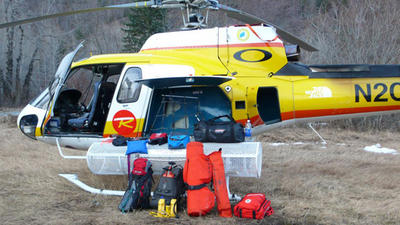http://espn.go.com/action/news/story?id=4399967
Morrison Hotel: Luggage Please
The things they carried (and/or ought to).
Comment Email Print Share
Morrison By Seth Morrison
Archive
What goes in a ski pack? Other than shovel and probe, I carry many other useful tools. Being stuck overnight or getting wet (like falling into a creek or stream) can be deadly quite quickly in the back or side country. Shelter, water, fire and food are the most important concerns if you're unable to get back from what was planned as a short adventure. Everything isn't listed here, but a few items can make the difference.

I always carry a sandwich-sized bag to keep tidy and dry the small odds and ends, including: Lighter, strike anywhere matches in waterproof container, dryer lint (good fire starter/tinder), aspirin, cut ointment, space blanket, compass, extra pack buckle, extra AAA batteries (for beacon and headlamp), duct tape and clothing patch tape. These items don't take up much space at all.
Also in the pack: Probe, shovel, a 45-foot length of orange cord (for cornice cutting and, if a situation arose, many other things), zip ties, collapsible water bottle, multi-tool, sundry snacks, head lamp, snow saw (doubles as limb cutting tool), skins, trekkers, radio (more for in your pocket to communicate with your crew or... potentially the outside world), cell phone (you may have service), monocular, heli-style ski strap (could come in handy if upper boot-buckles break, etc.), map (if you're going on a long trip), and an avalung (built into the pack). Mind you, all this fits in this pack rather tightly, and obviously you would have a larger pack for longer days; this is just a daypack for smaller adventures.
Most people are looking for light and fast when it comes to gear (skis and bindings), so they like touring bindings rather than trekkers—weight being the key issue. But most of my experience has been with trekkers since I like the feel of a real binding during descents. Using touring bindings to hike all-day or longer, well, less weight there makes sense.
Then the skis... Many people have made fun of me while out hiking in some popular skin areas for dragging up a pair of K2 Hellbents. But on the way down it's me who's laughing. The hike for me is for fitness—and to go down and enjoy the powder in the grand style that technology has provideth. Conditions, of course, dictate what skis I use.
First aid, you ask? I have had these kits from the store: Bandaids, gauze, aspirin, cut ointment. Sacrificing part of a layer to the cause will do too; probably not the most sterile solution, but better than nothing. Stabilizing a broken bone could be done with ski poles or tree limbs and duct tape. Doing what you have to do is what it comes down to, and trying to get out is the best solution unless you can call for help.
This is something to think about well before you head out in the back, side or slack country. And depending on your trip, you may want to have a Spot device—outdoor panic button for help. You have to set this up and have the proper info loaded on their website before use. Same goes for using a GPS unit—you need to know how it works along with a map with compass. What if it dies? Can you put in fresh batteries? Further, such gear isn't likely to be required in an area of short distance that you've spent a lot of time in and getting in-and-out of.

Still, pretty much you need to know what you're going to do if something happens. When we go heli filming our staff guide has all sorts of splints, a backboard, neck brace, unfoldable sled, oxygen, defibulator, over night bag, XXL first aid kits, Spots, GPS', UHF radios, flight tracking and heli backups. It is a crazy package and we all go through it. We're also trained on how everything works, including even how to turn off the heli's fuel in case of an accident, how to switch on the heli's ELT (Emergency Locator Transmitter), and how to take the ELT with you should that scenario present itself.
So get educated and have a plan; it's the most important part of an experience gone wrong. Let people know where you're going and what you're doing too—they may be the most valuable tool you can't fit in your pack.







